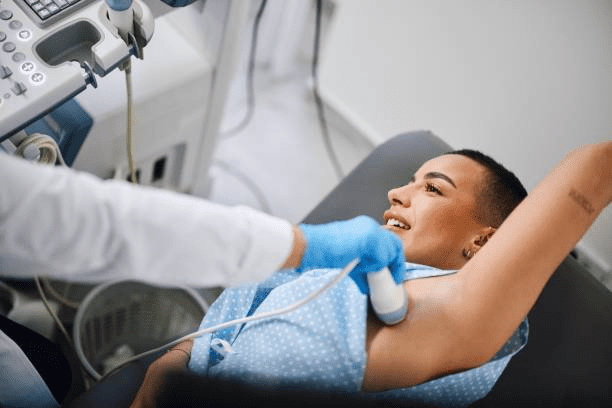Noticing a breast indentation when arm is raised can be both confusing and concerning. These subtle changes are often overlooked, but they can sometimes signal underlying issues that require medical attention. Before jumping to conclusions, it is important to understand what breast indentation really is and why it may occur.
Breast indentation refers to a visible dip, dent, or concave area on the surface of the breast. This change becomes more noticeable when the arm is lifted because the motion stretches the skin and underlying tissue, revealing irregularities that might not be obvious when at rest. The indentation can occur due to various reasons—some completely harmless, such as natural tissue changes or previous injuries, and others more serious, like underlying tumors pulling on the ligaments or skin from within.
While not every indentation is cause for alarm, it is always worth paying attention to changes in breast symmetry, contour, or skin texture—especially if they are new, worsening, or accompanied by other symptoms.
“One of the earliest signs of breast cancer isn’t always a lump—it can be a subtle indentation or dimpling that only appears when the arm is raised. These signs can be easy to miss, which is why awareness is so important.”
– Dr. Garvit Chitkara, a seasoned breast cancer surgeon in Mumbai
Now, let’s understand the reason behind the indentation.
Why Does Indentation Appear When You Raise Your Arm?
The structure of the breast includes fatty tissue, glands, ducts, and ligaments, all of which are connected to the skin. When you raise your arm, the skin and tissues stretch, making subtle indentations more noticeable. These indentations can be caused by:
Fibrous tissue pulling on the skin
Changes in breast fat distribution
Scar tissue or previous surgery
Trauma or injury to breast tissue
In many cases, the cause is benign. However, if the indentation is new or accompanied by other changes, it may be worth a closer look.
Have you noticed any unusual changes in your breast? Schedule a clinical breast exam today for reassurance and clarity.
Could It Be a Sign of Breast Cancer?
A breast indentation when arm is raised can, in some cases, be an early sign of breast cancer. Certain types of breast tumors grow in a way that tugs at surrounding tissue, creating a tethering effect that pulls the skin inward.
Dr. Garvit Chitkara, a breast oncology surgeon in Mumbai, emphasizes,
“One of the lesser-known symptoms of breast cancer is skin dimpling or indentation. It often appears before any lump is felt.”
While not all indentations point to cancer, it is important to consider them within the broader context of breast health.

Other Symptoms to Watch For
If you observe a breast indentation when arm raised, check for other accompanying signs, including:
A palpable lump
Changes in skin texture (like an orange peel appearance)
Nipple discharge
Unexplained swelling or shrinking of the breast
Redness or skin irritation
Nipple inversion or sudden changes in position
Symptoms of infection (redness, fever, warmth) appear
There is a noticeable decrease in mobility
Any combination of these symptoms should be assessed by a medical professional promptly.

What to Do If You Notice Indentation When You Lift Your Arm
If you see a breast indentation, don’t panic. Here’s what you can do:
Self-examine thoroughly:
Use a mirror to observe your breasts in different positions—arms down, arms raised, and hands pressed on hips.
Document the change:
Take note of when you first noticed the indentation, whether it is persistent, and if other symptoms have developed.

Avoid jumping to conclusions:
Not all changes are malignant. Hormonal shifts, weight changes, and benign cysts can also cause visible differences.
Schedule a clinical exam:
Get it checked by a specialist, preferably someone with experience in breast oncology, like Dr. Garvit Chitkara, who has managed hundreds of complex breast cases.
Concerned about a breast indentation or related symptoms? Get a diagnostic evaluation from an expert breast specialist. Schedule a consultation today.
Don’t wait if you notice the following changes.
When to Seek Medical Attention
While many indentations turn out to be harmless, it is important to consult a healthcare provider immediately if:While many indentations turn out to be harmless, it is important to consult a healthcare provider immediately if:
- The indentation is new or getting worse
- You detect a lump near the site
- Skin texture is changing or puckering
- There is a family history of breast cancer
- You are experiencing unexplained breast pain or nipple discharge

Prompt medical evaluation can help detect any serious conditions early and initiate appropriate care.
Wrapping Up
A breast indentation when arm is raised is not something to ignore. While there are various benign explanations, it could also signal something more serious like breast cancer. With breast health, awareness and early action are vital.
Dr. Garvit Chitkara, a breast cancer surgeon in Mumbai, advocates regular breast self-examinations and professional evaluations. Staying proactive can help detect any issues early and significantly improve treatment outcomes.
If you are noticing anything unusual in your breast—no matter how small—get it evaluated. It might just save your life.
Stay informed and stay ahead—schedule a breast health consultation with an expert today.
Frequently Asked Questions:
Can a breast indentation be normal?
Yes, in some cases, indentations can result from natural changes in breast tissue or benign conditions. However, if the indentation is new, persistent, or accompanied by other symptoms, it should be checked by a medical professional.
Is breast indentation a definite sign of cancer?
Not necessarily. While a breast indentation when arm raised can be a symptom of breast cancer, it can also be caused by non-cancerous issues. A clinical evaluation is the best way to determine the cause.
What kind of doctor should I consult for breast indentations?
A breast specialist or a breast oncology surgeon is best equipped to evaluate such symptoms and recommend next steps.
What tests are done if a breast indentation is found?
Common tests include a clinical breast exam, mammogram, ultrasound, and sometimes a biopsy to determine the nature of the tissue change.
How can I monitor breast changes at home?
Regular self-examinations in front of a mirror and during showers can help detect visual and physical changes early. Look for changes in shape, skin texture, or any new dimpling when raising your arms.
Research
https://pmc.ncbi.nlm.nih.gov/articles/PMC8682950
https://cancer.osu.edu/news/most-breast-cancers-dont-start-with-a-noticeable-lump

